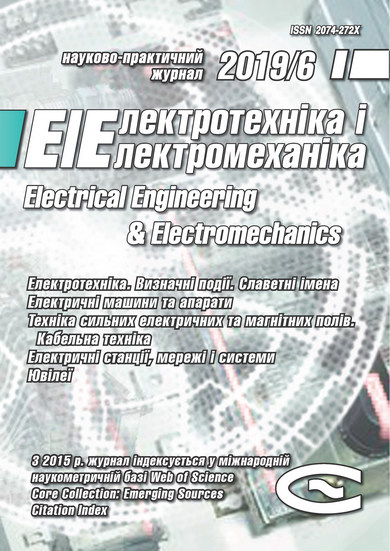EFFICIENCY OF APPLICATION OF SEMICONDUCTIVE COATINGS FOR REGULATION OF ELECTRIC FIELD IN HIGH-VOLTAGE INSULATION OF ELECTRIC MACHINES
DOI:
https://doi.org/10.20998/2074-272X.2019.6.06Keywords:
frontal part of the rod, external partial discharges, electric field, regulation of the electric field, semiconductive coating, surface resistivity, distribution of electric potential, stability of nonlinear properties, long-term electric and thermal aginAbstract
Introduction. Intensification of competition and the desire to reduce the cost of high-voltage electric machines due to a significant increase in the electrical and thermal loads of the electrical insulation system complicate the operation of anti-corona coatings on the insulation surface of the stator winding and increase the intensity of discharge processes, which significantly reduce the life of the insulation in case of failure of the coatings. Purpose. The analysis of the efficiency of alignment of the electric field along the insulation surface of the stator winding of high-voltage electric machines with semiconductor anti-corona coatings. Methodology. A method for calculating the electric potential distribution along the surface of the winding insulation during the use of semiconductive coatings providing alignment decrease the electric field and eliminating the appearance of moving discharges. The reliability of the calculations is confirmed by experimental studies of the potential distribution over the surface of the anti-corona semiconducting non-linear coating along the frontal part of the samples of the rod of the hydrogenerator for a linear voltage of 20 kV. Practical value. The proposed methodology for calculating the distribution of the electric field over the surface of the insulation and the anti-corona semiconductive coating can be applied to justify the length of the coating in the frontal part of high-voltage electrical machines depending on the electrophysical characteristics of the coating, electrical insulation, and thickness. The results of an experimental verification of the stability of the nonlinear properties of coatings during prolonged electrical and thermal aging of specially made coating samples are presented.References
Grubelnik W., Roberts J., Koerbler B., Marek P. A new approach in insulation systems for rotating machines. Proceedings Electrical Insulation Conference and Electrical Manufacturing Expo, 2005. doi: 10.1109/eeic.2005.1566267.
Dal Mult G., Oldrati A., Zuninow F. New insulation systems for upgrading large turbogenerator driven by gas and steam turbines. Proceedings of 16th International Conference DISEE, 2001, pp. 97-100.
Insulating Systems for High-Voltage Rotating Machines. Available at: https://www.vonroll.com/userfiles/downloads/1535723465310105/1.02.1_HV%20MOTORS_EN.pdf (accessed 15.08.2018).
Ogonkov V.G., Serebryannikov S.V. Elektroizoliatsionnye materialy i sistemy izoliatsii dlia elektricheskikh mashin. V dvukh knigakh. Kn. 2 [Electrical insulation materials and insulation systems for electrical machines. In 2 books. Book 2]. Moscow, Publishing house MEI, 2012. 304 p. (Rus).
Espino-Cortes F.P., Cherney E.A., Jayaram S. Effectiveness of stress grading coatings on form wound stator coil groundwall insulation under fast rise time pulse voltages. IEEE Transactions on Energy Conversion, 2005, vol.20, no.4, pp. 844-851. doi: 10.1109/tec.2005.853745.
Okamoto T., Yoshiyuki I., Kawahara M., Yamada T., Nakamura S. Development of potential grading layer for high voltage rotating machine. Conference Record of the 2004 IEEE International Symposium on Electrical Insulation. doi: 10.1109/elinsl.2004.1380524.
Malamud R.E., Bagaley Yu.V. New anti-corona enamel. Electrotechnical industry, 1963, no.7, pp. 11-15. (Rus).
Malamud R.E., Bagaley Yu.V. Study of the laws of obtaining nonlinear properties of semiconducting enamels based on silicon carbide powders. Electricity, 1976, no.9, pp. 63-66. (Rus).
Gegenava A.G. Properties of anti-corona coating of stator windings of high voltage electric machines. Electricity, 2002, no.9, pp. 64-66. (Rus).
Bezprozvannych G.V., Boyko A.N., Roginskiy A.V. Effect of a dielectric barrier on the electric field distribution in high-voltage composite insulation of electric machines. Electrical engineering & electromechanics, 2018, no.6, pp. 63-67. doi: 10.20998/2074-272X.2018.6.09.
Naboka B.G., Bezprozvannych A.V. Metodicheskie ukazaniia k resheniiu zadach optimizatsii konstruktsii vysokovol'tnykh izoliatsionnykh promezhutkov po kursu «Raschet i konstruirovanie izoliatsii» [Methodical instructions to solving structural optimization of high insulation spaces on the course «Calculation and design of isolation»]. Kharkov, 1988. 30 pp. (Rus).
Kuchinsky G.S. Chastichnye razriady v vysokovol'tnykh konstruktsiiakh [Partial discharges in high voltage structures]. Leningrad, Energiia Publ., 1979. (Rus).
Bezprozvannych A.V. High electric field and partial discharges in bundled cables. Technical electrodynamics, 2010, no.1, pp. 23-29. (Rus).
Bezprozvannych G.V., Kyessayev A.G., Mirchuk I.A., Roginskiy A.V. Identification of technological defects in high-voltage solid insulation of electrical insulation structures on the characteristics of partial discharges. Electrical engineering & electromechanics, 2019, no.4, pp. 53-58. doi: 10.20998/2074-272X.2019.4.08.
Downloads
Published
How to Cite
Issue
Section
License
Copyright (c) 2019 G. V. Bezprozvannych, A. V. Roginskiy

This work is licensed under a Creative Commons Attribution-NonCommercial 4.0 International License.
Authors who publish with this journal agree to the following terms:
1. Authors retain copyright and grant the journal right of first publication with the work simultaneously licensed under a Creative Commons Attribution License that allows others to share the work with an acknowledgement of the work's authorship and initial publication in this journal.
2. Authors are able to enter into separate, additional contractual arrangements for the non-exclusive distribution of the journal's published version of the work (e.g., post it to an institutional repository or publish it in a book), with an acknowledgement of its initial publication in this journal.
3. Authors are permitted and encouraged to post their work online (e.g., in institutional repositories or on their website) prior to and during the submission process, as it can lead to productive exchanges, as well as earlier and greater citation of published work.





